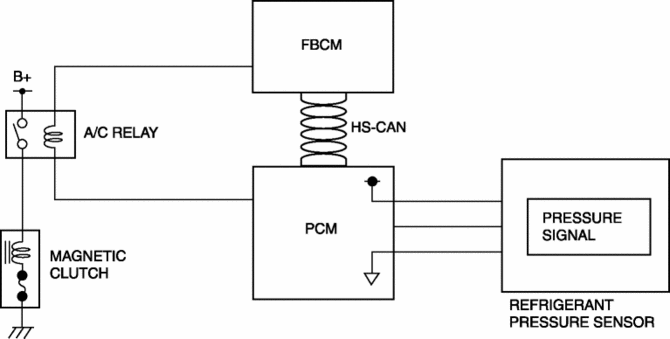Mazda CX-5 Service & Repair Manual: Refrigerant Pressure Sensor [Full Auto Air Conditioner]
Purpose
-
The refrigerant pressure sensor detects the refrigerant pressure in the refrigerant cycle.
Function
-
The refrigerant pressure sensor converts the detected refrigerant pressure to an electric signal and sends it to the PCM.

Construction
-
The refrigerant pressure sensor is installed on the cooler pipe.

-
A capacitance type refrigerant pressure sensor, which converts refrigerant pressure into a linear electric signal, has been adopted.
-
Consists of a pressure detecting part and signal processing part.
-
The pressure detecting part is a variable capacity condenser, which changes capacitance according to the pressure.
-
The signal processing part detects the capacitance of pressure detecting part, converts it to voltage, then outputs it to the climate control unit.

Operation
Capacitance type
-
There is a clearance between the movable ceramic diaphragm and the ceramic base, and each side has an electrode.
-
When pressure is applied from the ceramic diaphragm side, the ceramic diaphragm deforms, and the clearance between the electrodes changes. As a result, capacitance is changed and pressure is detected.

Fail-safe
-
Function not equipped.
 Refrigerant Pressure Sensor Removal/Installation [Manual Air Conditioner]
Refrigerant Pressure Sensor Removal/Installation [Manual Air Conditioner]
1. Disconnect the negative battery cable..
2. Discharge the refrigerant..
3. Disconnect the refrigerant pressure sensor connector.
CAUTION:
If moisture or foreign material enters the ref ...
 Refrigerant Pressure Sensor [Manual Air Conditioner]
Refrigerant Pressure Sensor [Manual Air Conditioner]
Purpose
The refrigerant pressure sensor detects the refrigerant pressure in the refrigerant
cycle.
Function
The refrigerant pressure sensor converts the detected refrigerant pre ...
Other materials:
Power Steering
Power Steering
• Power steering is only operable when the
engine is running. If the engine is off or if the power steering system is inoperable,
you can still steer, but it requires more physical effort.
If the steering feels stiffer than usual during normal driving or the steering
vibrate ...
Roof Molding Removal
1. Insert a tape-wrapped flathead screwdriver in the position shown in the figure.
2. Rotate a tape-wrapped flathead screwdriver in the direction of the arrow in
the order of (1), (2) shown in the figure and remove the roof molding from the front
T-stud.
3. Rotate the roof molding in th ...
Airflow Mode Main Link Removal/Installation
Full-auto Air Conditioner
1. The airflow mode main link is installed to the airflow mode actuator. When
removing the airflow mode main link, refer to the airflow mode actuator removal/installation..
Manual Air Conditioner
1. Disconnect the negative battery cable..
2. Remove the glove compar ...
